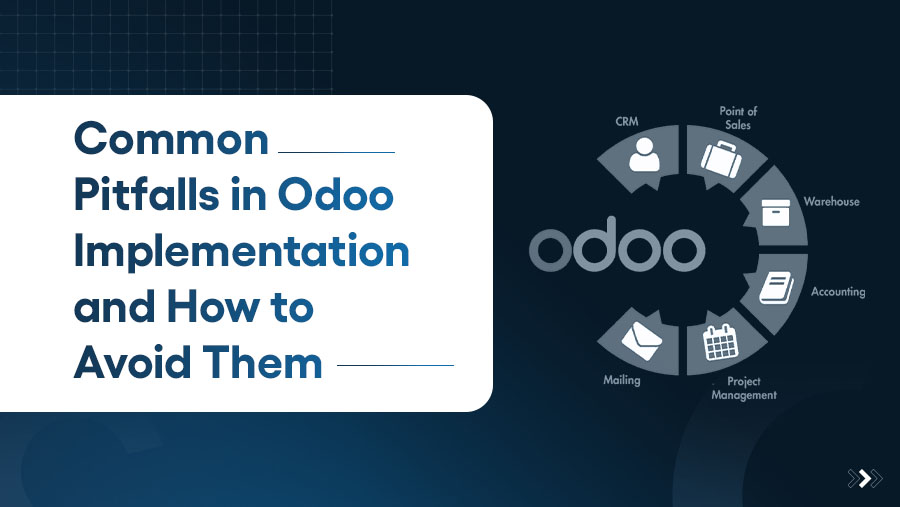
Common Pitfalls in Odoo Implementation and How to Avoid Them
Deepti

Odoo is a powerful business management platform that covers everything- from accounting and inventory to CRM, HR, and marketing. It’s flexible, modular, and scalable. But if not implemented carefully, things can go wrong.
This blog will walk you through the most common Odoo implementation mistakes, explain why they happen, and offer simple solutions to avoid them.
1. Starting Odoo Implementation Without a Clear Plan
One of the most common Odoo implementation mistakes is starting without a clear plan.
Many businesses get excited about using Odoo and jump straight into setting it up. They start adding apps, creating user roles, and importing data—without first understanding how their teams actually work.
This often leads to problems like:
- Teams using different workflows that don’t connect with each other
- Important features being set up incorrectly or not used at all
- Business processes being left out because they weren’t discussed in the beginning
When the system doesn’t match how people work, it causes confusion. Employees may stop using it and go back to old tools like spreadsheets or emails.
How to Avoid It
To avoid these early Odoo implementation pitfalls, take a step back before you begin.
- Identify your key challenges first
Instead of thinking in terms of apps or modules, think in terms of pain points. Are you struggling with inventory accuracy? Do you lack sales pipeline visibility? Is project tracking inconsistent? - Involve every department
Odoo will affect multiple teams—from sales and finance to warehouse and HR. Make sure everyone’s workflows and expectations are considered from the beginning. - Start small and build gradually
Pick one or two core business processes and implement those first. Once those are running smoothly, you can expand to other areas.
Example:A retail company was facing issues with stock mismatches and slow billing at checkout. Instead of using multiple apps at once, they started by implementing just the Inventory and Point of Sale (POS) modules in Odoo. After their team got used to the system and stock tracking improved, they added eCommerce and email marketing three months later. This step-by-step approach helped the team stay confident and reduced mistakes during setup
2. Choosing an Inexperienced Odoo Implementation Partner
Another major Odoo implementation mistake is working with the wrong partner.
Odoo looks simple during a demo. But when it’s time to set it up for your business—connecting different apps, mapping workflows, migrating data, customizing features, it becomes much more complex.
Some businesses hire general IT consultants or rely on internal developers. While this might seem cost-effective at first, these teams often don’t have deep experience with Odoo. They might try to make things work using custom code or quick fixes that don’t follow Odoo’s best practices.
Here’s what usually happens:
- Workarounds are used instead of using standard Odoo features
- Modules break or stop working after an update
- You face delays and extra costs whenever changes are needed
In short, you end up with a system that looks like Odoo on the surface but doesn’t function well in daily operations.
How to Avoid It
To avoid these Odoo implementation pitfalls, it’s important to choose the right Odoo partner, who understands both the technical side and the real-world business use of the platform.
Here’s what to look for:
- Work with a certified or official Odoo partner
These teams have proven experience and stay updated with the latest Odoo features and guidelines. They also follow structured implementation methods. - Ask for industry-specific experience
Not all businesses are the same. If you’re in retail, manufacturing, services, or education—your processes differ. Choose a partner who has worked on similar projects. - Confirm they offer complete Odoo implementation services
Setup alone isn’t enough. You’ll need support for planning, data migration, user training, testing, and post-launch improvements.
According to Software Advice, 75% of Implementation failures are caused by poor vendor support or lack of product knowledge. Choosing an inexperienced team can cost far more in the long run—both in time and lost productivity.
3. Implementing All Odoo Modules at Once
One of the frequent Odoo implementation pitfalls is trying to roll out too many modules at the same time.
Odoo offers a wide range of apps—Sales, CRM, Accounting, Inventory, HR, Website, Marketing, and more. For businesses excited about digital transformation, it can be tempting to activate them all at once.
But doing so without a proper sequence can quickly overwhelm your teams.
Here’s what usually happens:
- Users receive too much information and can’t learn the system properly
- Go-live dates get pushed back because no team is fully ready
- Teams make mistakes due to unfamiliarity, leading to incorrect data or broken workflows
- Focus is scattered, and no module performs optimally
When everything is new, nothing feels comfortable—and adoption suffers.
How to Avoid It
A smoother Odoo rollout starts with phased implementation. Here’s how to approach it:
- Identify your most urgent needs first
Start with the modules that solve immediate business problems. This could be Inventory for stock management, CRM for tracking leads, or Accounting for invoicing. - Roll out in clear stages
Implement the first module (or two), give your team time to adapt, and ensure everything works well before adding the next. This gives users confidence and allows for focused training. - Set simple success criteria
Decide how you’ll measure progress before moving to the next phase. For example, “100% of sales reps logging daily activities in CRM” or “zero inventory mismatch for 30 days.”
Example:
A manufacturing company had planned to use Odoo for everything—from procurement to payroll. But instead of launching all modules together, they took a phased approach.
- Phase 1: Started with Purchase and Inventory to streamline their supply chain
- Phase 2: Added Accounting once their operations stabilized
- Phase 3: Introduced HR and Payroll after six months, when employees were already comfortable using Odoo daily
This step-by-step rollout helped each department focus, learn, and succeed without feeling overwhelmed.
4. Skipping Pre-Migration Cleanup and Testing in Odoo
Among the more technical but equally critical Odoo implementation pitfalls is underestimating the complexity of data migration.
Many businesses assume that importing data from spreadsheets or older systems into Odoo will be quick and straightforward. But in reality, this step requires careful planning. When it’s rushed or done without proper checks, the results can affect your entire system.
Here’s what can go wrong:
- Financial reports show incorrect balances because of mismatched transaction records
- Duplicate customers or vendors appear due to inconsistent naming or IDs
- Important sales or inventory fields are left empty or imported incorrectly
These errors aren’t just technical—they can confuse users, delay operations, and create trust issues with the new system.
How to Avoid It
A smooth transition starts with treating data migration as a project of its own, not a checklist item.
- Clean and prepare your data in advance
Before importing, go through your existing data. Remove duplicates, fill in missing information, and check for inconsistencies (like date formats or currency types). - Use a sandbox environment for test migrations
Run a test import in a separate trial database. This helps catch formatting errors or mismatches before they affect your live system. - Map fields carefully
Make sure every field in your old system has a corresponding place in Odoo. This is especially important for key data like customer addresses, product SKUs, and payment terms.
Example:
A service-based company was migrating its customer invoices into Odoo. During import, they didn’t notice that the date formats in their old system used MM/DD/YYYY, while Odoo required DD/MM/YYYY. As a result, the invoice history appeared out of order and totals were inaccurate. Running a simple test import in a sandbox would have flagged this issue early—before it affected financial reports.
5. Over-Customizing the Odoo Platform
It’s natural to want your new system to work exactly like the one you’re used to. Many businesses try to replicate every detail of their old software when setting up Odoo. But that approach often leads to one of the most overlooked Odoo implementation pitfalls: unnecessary customization.
Odoo is flexible, but that doesn’t mean everything should be custom-built.
Too much customization can:
- Make upgrades difficult, as custom code may not work with new Odoo versions
- Create a heavy reliance on developers, slowing down changes
- Break connections with standard Odoo modules and apps
Over time, the system becomes harder to manage, more expensive to maintain, and less aligned with Odoo’s core strengths.
How to Avoid It
Smart implementation doesn’t mean recreating your old system—it means improving it.
Here are a few Odoo best practices to follow:
- Customize only when it adds clear value
If a process is unique to your business and brings real operational or customer benefit, it may be worth customizing. But always weigh the long-term cost and maintenance needs. - Test custom features in a separate database
Before going live, try out custom developments in a duplicate or test environment. This helps catch bugs and ensures compatibility with other modules.
Example:
A company built a 10-step approval process in Odoo using custom code. But they could’ve done it easily with Odoo’s built-in features—no coding needed. This would’ve saved them time and avoided future problems with updates and fixes.
6. Neglecting Post-Implementation Support and Improvement
Odoo implementation doesn’t end when the system goes live.
Many companies make the mistake of thinking their job is done after setup. Once the team starts using the system, they move on to other priorities and stop looking for ways to improve or expand.
This often leads to:
- Useful features or modules being forgotten or never explored
- Bugs or inefficiencies going unnoticed and unresolved
- The system falling out of sync with changing business needs
As your business evolves—new teams, new processes, new goals—your Odoo setup should evolve too. If it doesn’t, the system gradually becomes less useful and harder to maintain.
How to Avoid It
To keep Odoo working smoothly long after launch, build a habit of continuous improvement. Here are some Odoo best practices to follow:
- Assign a system owner internally
This person doesn’t need to be a developer—they just need to understand your business and be responsible for collecting feedback, logging issues, and coordinating small improvements. - Review system performance every 3 to 6 months
Hold regular check-ins with key users to see what’s working and what’s not. Are there features that aren’t being used? Are teams still relying on manual workarounds? - Stay updated with the Odoo ecosystem
Odoo releases new versions and features regularly. Join community forums, follow release notes, and see if any new tools can make your processes better or simpler.
Example:
A company had been using Odoo for nearly two years, mainly for sales and invoicing. During a review, they discovered the reporting dashboard feature—which they had never explored. After enabling it and setting up weekly reports, their managers were able to spot sales trends faster and make better decisions. A small change led to a big impact—simply because they revisited the system after go-live.

Final Thoughts
Implementing Odoo can bring huge benefits—but only if you take the right approach from the start. Each of these challenges is preventable. The key is to:
- Plan realistically
- Start simple
- Clean your data
- Train your users
Think long-term
By keeping these points in mind, you’ll avoid common mistakes and follow Odoo best practices that lead to long-term success.
News Letter
Subscribe our newsletter to get our
latest update & news
Ready to Explore Odoo?
Let our experts at Softbay walk you through a personalized demo or consult on your ERP roadmap.


